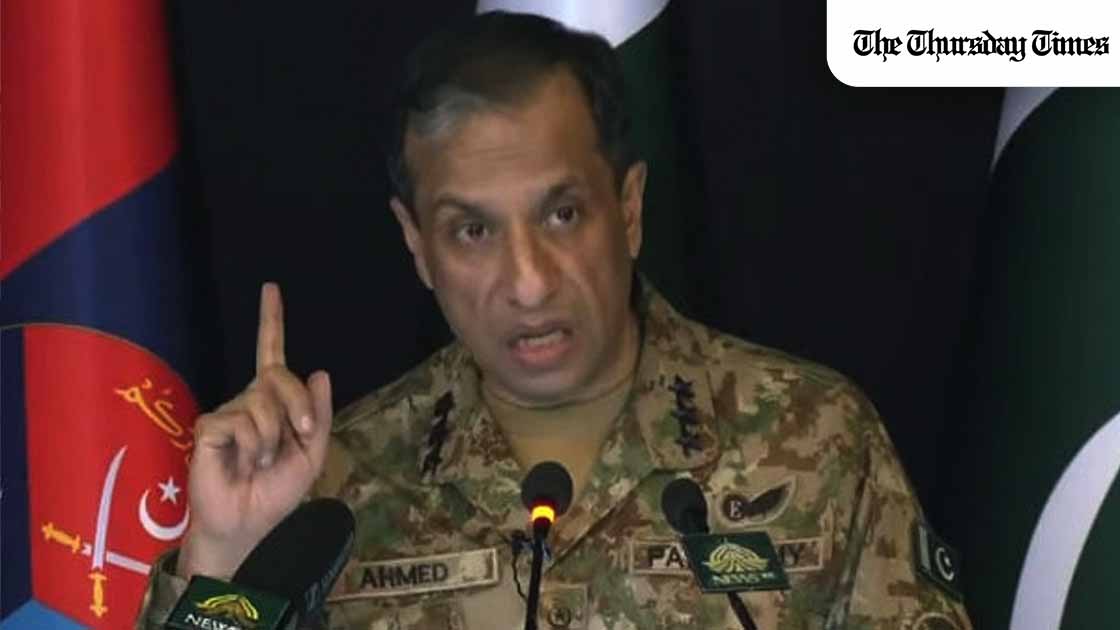ISLAMABAD (The Thursday Times) — Pakistan’s military spokesperson, DG ISPR General Ahmed Sharif, has set out a hard-edged account of the country’s security challenge in an interview with German media, describing violence in Balochistan and Khyber Pakhtunkhwa as terrorism rather than extremism, alleging it is organised from Afghan territory with Indian direction, and underscoring that the state views militants as criminals divorced from any religion or ethnicity. He further contends that Afghanistan is now stable and economically improving, a premise used to argue that Afghan citizens no longer require refuge inside Pakistan.
The message arrives after years of overlapping insurgencies, sectarian killings and targeted attacks that blurred political grievance with organised violence. The new line seeks to cut through that fog. It moves the debate from theology to logistics; not who people are, but how networks move personnel, money and materiel across borders. In this telling, the decisive battleground is no longer the street or the sermon but the corridor, the safe house and the remittance channel. By stripping away the aura of ideology, the state attempts to drain any residual legitimacy from armed groups and to place them squarely in the frame of organised coercion.
Framed this way, Balochistan and Khyber Pakhtunkhwa are recast as theatres subjected to imported violence rather than sites of unresolved domestic conflict. The allegation points a finger at Indian hands and Afghan soil, presenting a picture of proxy pressure that outsources risk while importing consequences. The intended audience is not only domestic. Foreign capitals, multilateral bodies and watchdogs are invited to weigh border management, financial interdiction and the duties of neighbours who claim effective control of their territory. If terrorism is exported, the narrative implies, accountability must be imported as well.
The posture on refugees flows from that same logic. If Afghanistan is peaceful and conditions are improving, extended sanctuary loses its humanitarian rationale. The argument presses Kabul to demonstrate stewardship at home while offering Islamabad grounds to tighten repatriation, regularise undocumented flows and align migration controls with counter-terror finance measures. It also nods to urban realities in Pakistani cities where labour markets, housing and services bear the weight of prolonged displacement. Through this lens, security and economics sit in the same queue, drawing from the same pool of political capital.
Yet the credibility test remains exacting. Sweeping claims demand shareable indicators without burning sources. Forensic timelines that link planners to operations, financial trails that map transfers to attacks, and custody statements that survive courtroom scrutiny will be needed if Islamabad wants sceptical audiences to accept its case. The state’s own communications acknowledge that evidence remains the coin of the realm; the higher the allegation, the higher the evidentiary bar. Without that granularity, critics will default to older doubts about blame-shifting and selective memory.
On the ground, the immediate implications are clear. Expect stricter frontier controls, deeper screening of transit routes and remittances, and stronger conditionality in any diplomatic engagement with Kabul. Expect a media strategy that keeps religion and ethnicity outside the frame, in order to avoid communal contagion and to hold the line at public order. Expect, too, a renewed push to classify armed outfits by capability rather than creed, a taxonomy that helps planners match tools to threats: policing where it suffices, targeted force where it does not, and financial disruption to starve logistics.
The economic strand is not incidental. By asserting that Afghanistan’s economy is strengthening, Islamabad sets a benchmark that Kabul must meet in practice rather than prose. If the neighbour is indeed stable, then the persistence of cross-border sanctuaries becomes harder to explain away. If trade corridors and customs posts are functional, then the circulation of weapons and fighters points to permissive seams. The line is as much about regional commerce as it is about coercion; stable borders should carry goods, not gunmen.





